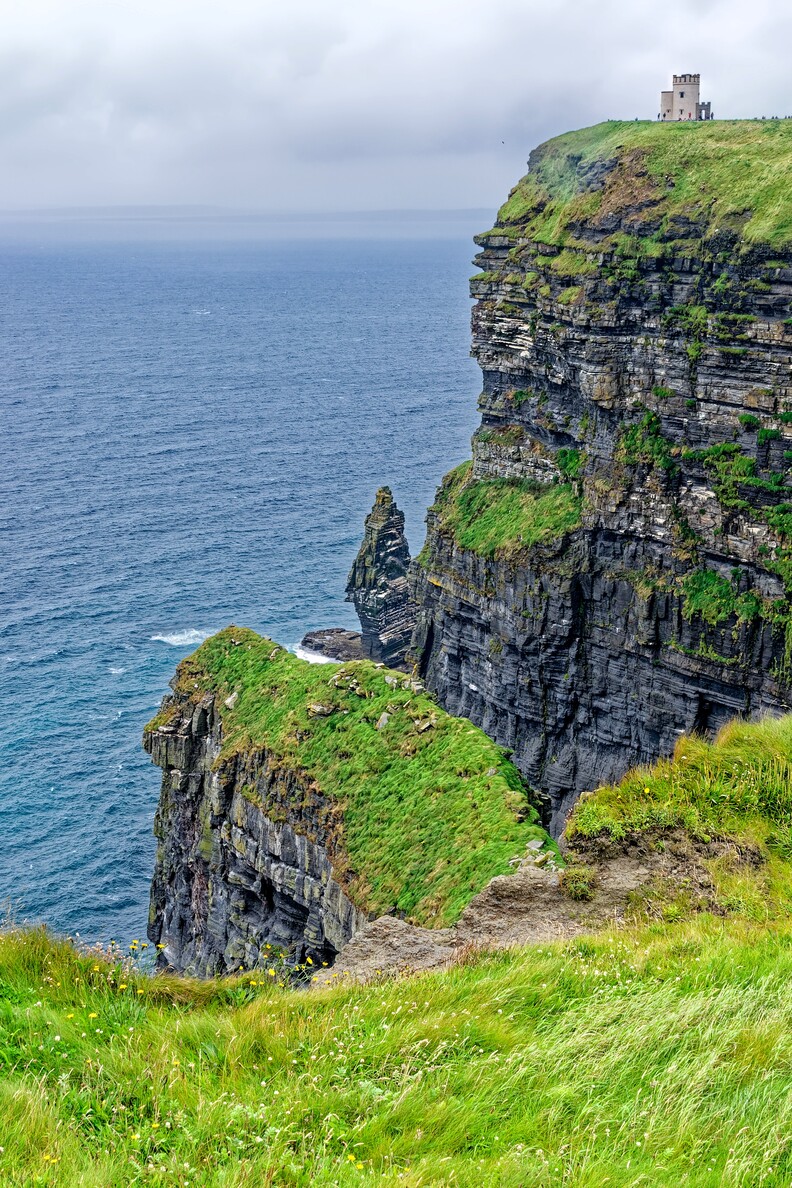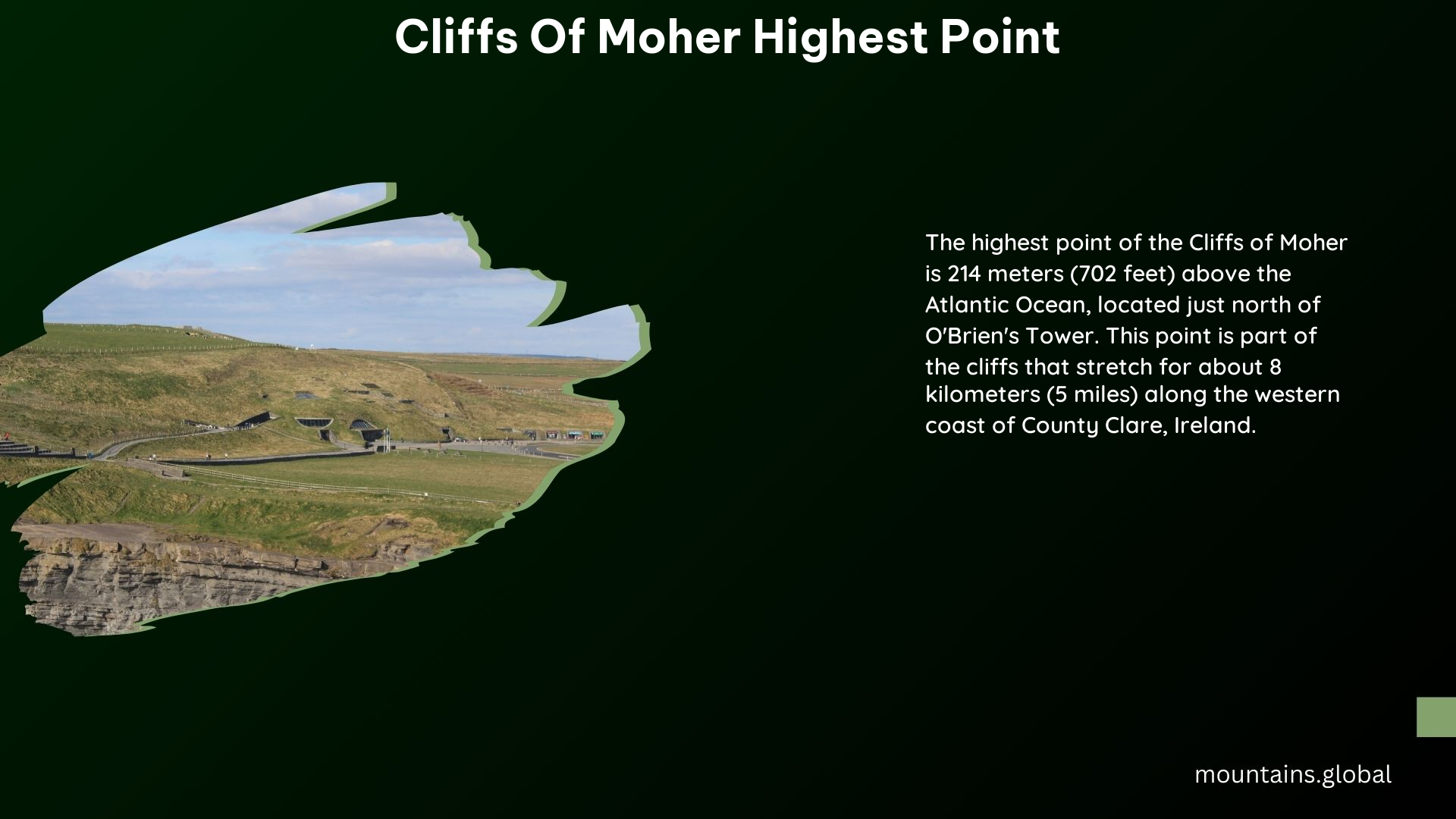The Cliffs of Moher, one of Ireland’s most iconic natural wonders, reach their pinnacle at a breathtaking 214 meters (702 feet) above the Atlantic Ocean. This highest point, located just north of O’Brien’s Tower, offers visitors an awe-inspiring panorama of rugged coastline, crashing waves, and endless horizons. The cliffs stretch for 8 kilometers (5 miles) along County Clare’s western seaboard, attracting over 1.5 million visitors annually to witness their majestic beauty and geological significance.
What Makes the Highest Point So Special?

The highest point of the Cliffs of Moher is a testament to the raw power of nature and the enduring allure of Ireland’s landscape. At 214 meters above sea level, this vantage point offers:
- Unparalleled views of the Atlantic Ocean
- Panoramic vistas of the Aran Islands
- Glimpses of the Twelve Bens and Maumturks mountain ranges in Connemara
- A bird’s-eye view of the cliff face and its diverse ecosystem
The sheer height and dramatic drop create a sense of awe that’s hard to replicate elsewhere. On clear days, visitors can see up to 50 kilometers in each direction, making it a photographer’s paradise and a nature lover’s dream.
How Can Visitors Access the Highest Point?

Reaching the highest point of the Cliffs of Moher is relatively straightforward:
- Follow the official Cliffs of Moher Coastal Walk
- Head north from the Visitor Centre towards O’Brien’s Tower
- Continue past the tower for a short distance
- Observe safety barriers and stay on designated paths
It’s crucial to note that while the allure of getting closer to the edge may be strong, it’s extremely dangerous and strictly prohibited. The official paths provide safe access to stunning viewpoints without risking your life.
What Geological Features Can Be Observed from the Highest Point?
From this elevated position, visitors can witness the remarkable geological history of the Cliffs of Moher:
- Layered Rock Formations: The cliffs showcase 300 million years of geological history, with distinct layers of Namurian shale and sandstone visible.
- Sea Stacks: Erosion-resistant pillars of rock stand isolated from the main cliffs, testament to the power of the Atlantic waves.
- Sea Caves: At the base of the cliffs, numerous caves have been carved out by the relentless action of the sea.
- Fault Lines: Visible cracks and shifts in the rock layers reveal the dynamic forces that have shaped the landscape over millennia.
This unique vantage point offers geologists and casual observers alike a chance to appreciate the Earth’s incredible forces at work.
What Wildlife Can Be Spotted from the Highest Point?
The Cliffs of Moher are not just a geological marvel but also a thriving ecosystem. From the highest point, keen-eyed visitors might spot:
| Species | Best Time to Observe | Interesting Fact |
|---|---|---|
| Atlantic Puffins | April to July | They can dive up to 60 meters deep |
| Razorbills | Year-round | They can live up to 40 years |
| Kittiwakes | March to September | They are the most oceanic of the gull species |
| Peregrine Falcons | Year-round | The fastest animals in the world, reaching speeds of over 320 km/h during hunting dives |
| Choughs | Year-round | These rare birds are members of the crow family |
Binoculars are highly recommended for wildlife enthusiasts looking to make the most of their visit to the highest point.
How Does Weather Affect the Experience at the Highest Point?
The weather at the Cliffs of Moher can be unpredictable and plays a significant role in the visitor experience:
- Clear Days: Offer the best visibility, allowing visitors to see the Aran Islands and distant mountains.
- Foggy Conditions: Can obscure views but create a mystical atmosphere.
- Windy Weather: Common at the cliffs, adding to the dramatic experience but requiring caution.
- Rainy Days: May limit visibility but showcase the cliffs’ rugged beauty in a different light.
It’s advisable to check the weather forecast before visiting and be prepared for rapid changes in conditions. The Visitor Centre provides real-time weather updates to help plan your experience.
What Facilities Are Available Near the Highest Point?
While the highest point itself is a natural area, nearby facilities enhance the visitor experience:
- O’Brien’s Tower: Just a short walk from the highest point, offering indoor viewing and historical context.
- Visitor Centre: Located about 10 minutes walk south, providing:
- Interactive exhibits
- Café with panoramic views
- Gift shop
- Restroom facilities
- Information Points: Scattered along the path, offering insights into the cliffs’ geology, history, and wildlife.
These amenities allow visitors to comfortably spend several hours exploring the area around the highest point.
How Has the Highest Point Changed Over Time?
The highest point of the Cliffs of Moher, like the rest of the cliffs, is in a constant state of slow change:
- Erosion: The cliffs recede by approximately 1 meter every 100 years due to wave action and weathering.
- Conservation Efforts: In recent decades, measures have been implemented to protect the cliffs from excessive erosion caused by human activity.
- Tourism Infrastructure: The development of safe viewing platforms and paths has changed how visitors interact with the highest point.
- Ecological Changes: Climate change and conservation efforts have influenced the types and numbers of species that call the cliffs home.
Understanding these changes helps visitors appreciate the dynamic nature of this seemingly timeless landscape.
What Are the Best Times to Visit the Highest Point?
Timing your visit to the highest point can greatly enhance your experience:
- Sunrise/Sunset: Offers spectacular lighting conditions for photography and a more serene atmosphere.
- Off-Peak Hours: Early morning or late afternoon visits often mean fewer crowds.
- Seasonal Considerations:
- Spring: Best for birdwatching as nesting season begins
- Summer: Busiest season with longest daylight hours
- Autumn: Dramatic skies and potential for storm watching
- Winter: Fewer crowds but more unpredictable weather
Regardless of when you visit, the highest point of the Cliffs of Moher promises an unforgettable experience of Ireland’s natural beauty.
References:
1. Cliffs of Moher Official Website
2. Geological Survey Ireland – Cliffs of Moher
3. BirdWatch Ireland – Cliffs of Moher
